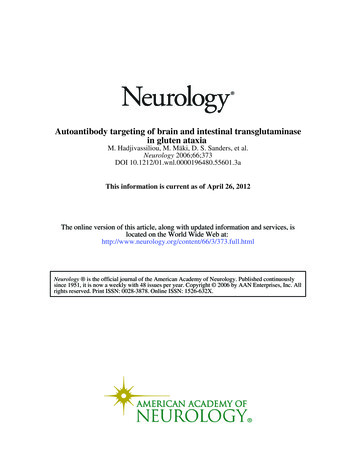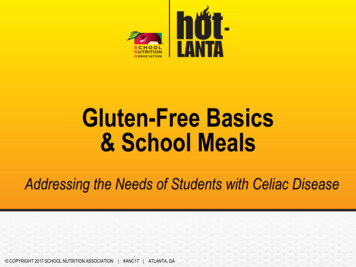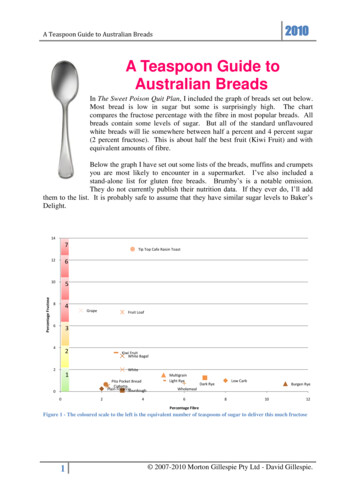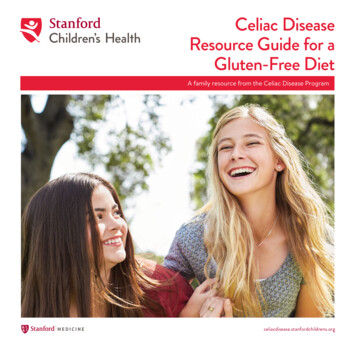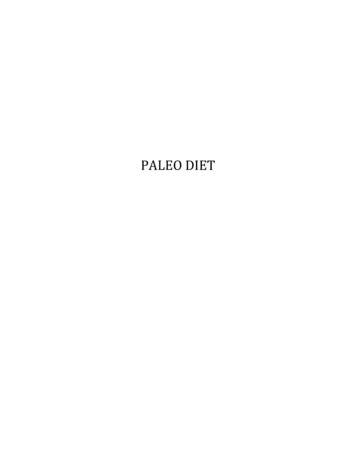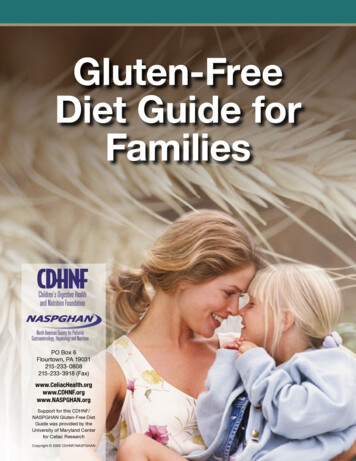
Transcription
Gluten-FreeDiet Guide forFamiliesPO Box 6Flourtown, PA 19031215-233-0808215-233-3918 .orgSupport for this CDHNF/NASPGHAN Gluten-Free DietGuide was provided by theUniversity of Maryland Centerfor Celiac ResearchCopyright 2005 CDHNF/NASPGHAN
view the gluten-free diet and any other specific nutritionalneeds of your child. The registered dietitian will be able tohelp you contact local support groups and direct you toreliable web sites.WHAT IS GLUTEN?Gluten is the general name for one of the proteins found inwheat, rye, and barley. It is the substance in flour that formsthe structure of dough, the “glue” that holds the producttogether and is also the leavening ingredient. When theseproteins are present in the diet of someone with CD, theybecome toxic and cause damage to the intestine. Thisdamage leads to decreased absorption of essential nutrients and, if left untreated, can lead to nutrient deficiencyand subsequent disease (i.e. iron deficiency anemia, decreased bone density, unintentional weight loss, folate andvitamin B12 deficiency).TABLE OF CONTENTSIntroduction . . . . . . . . . . . . . . . . . . . . . . . . . . . . . . 2What can the celiac patient eat? . . . . . . . . . . . . . 3How do I start . . . . . . . . . . . . . . . . . . . . . . . . . . . . 3Gluten-Free Shopping List . . . . . . . . . . . . . . . . . . 4Life goes on! . . . . . . . . . . . . . . . . . . . . . . . . . . . . . 6WHERE IS GLUTEN FOUND?Once the diet has started . . . . . . . . . . . . . . . . . . . 7Food/grainsResources . . . . . . . . . . . . . . . . . . . . . . . . . . . . . . . 8The grains containing gluten include wheat, rye, barley, andall their derivatives (see Table 1 for a listing of grains to beavoided). These grains are used in such items as breads,cereals, pasta, pizza, cakes, pies, and cookies and as added ingredients to many processed food items.IntroductionIf your child has just been diagnosed with celiac disease(CD), you may be experiencing mixed feelings. On onehand, no one likes to hear that his or her child has any kindof medical condition. However, you may be relieved to finally have the answer to your child’s past medical problems. You may also feel better knowing that celiac diseaseis a treatable disorder, that intestinal damage from celiacdisease is reversible, and that therapy does not involveshots, pills, therapy or surgery. You may also feel confused,overwhelmed or unsure about how to start the healing process.Table 1. Gluten containing grains to avoidBarleyBarley inaAfter getting nutritional advice, some parents head straightto the grocery store to stock up on gluten-free (GF) products for their child. They may spend hours in the grocerystore, but leave with only a small bag of groceries and noidea of what to serve for dinner. They may experience theso called “Celiac Meltdown”!FaroGraham flourKamutMatzo eUdonWheatWheat branWheat germWheat starchIMPORTANT REMINDER: This information from theCDHNF is intended only to provide general information and not as a definitive basis for diagnosis or treatment in any particular case. It is very important thatyou consult your doctor about your specific condition.The purpose of this booklet is to help prevent newly diagnosed celiac patients and their families from experiencing“Celiac Meltdown. This booklet is a starter guide that willhelp you through the initial days of the gluten-free lifestyleand is designed to help you and your family manage theemotional stress that you may be feeling right now.For more information or to locate a pediatricgastroenterologist in your area please visitour website at: www.naspghan.orgThe most important first step is to work with your physicianand a knowledgeable registered dietitian (RD) who will re-www.CeliacHealth.org www.CDHNF.org www.NASPGHAN.org2
What Can The Patient WithCeliac Disease Eat?Overlooked Sources of GlutenIn order to completely remove gluten from your diet, lessobvious sources of gluten must also be identified andavoided. You may find gluten in products, listed in table 2.You may be uncertain about what to feed your child because it seems that there is so much that a patient withceliac disease can’t eat. Not to worry, there are many foodsthat will fit into your child’s diet that are naturally gluten–free(see Table 3 for a listing of GF grains and starches). Thereare also a variety of gluten-free substitutes to replace oldfavorites like pizza, pasta and bagels.Table 2. Overlooked gluten sourcesAlesBeer and LagersBreadingBrown Rice SyrupCoating MixCommunion WafersCroutonsCandyLuncheon MeatsBrothPastaRouxSaucesSoup BaseStuffingSelf-basting PoultryImitation Bacon/seafoodSoy SauceMarinades Thickeners HerbalSupplements,Prescription MedicationsAnd Over The Counter MedicationVitamin And Mineral SupplementsLipstickGloss And BalmsPlay Dough*Table 3. Gluten-free grains and starchesAmaranthArrowrootBuckwheatCornFlaxFlours made fromnutsbeans and seedsMilletMontina Potato starch*The gluten protein does not pass through the skin. However,hands need to be properly washed after handling play doughand prior to eating to avoid cross contamination.Potato flourQuinoaRicerice branSagoSorghumSoy (soya)TapiocaTeffDistilled vinegars are gluten-free as all distilled productsdo not contain any harmful gluten proteins. Malt vinegar,however, is not distilled and therefore contains gluten.Be sure to read all labels carefully. If a product has questionable ingredients, avoid it until the manufacturer confirms that the product is gluten-free. Labels must be readevery time you purchase food because ingredients in aproduct can change at any timeWHAT ABOUT OATS?Many recent studies indicate that the protein found in oatsmay not be harmful to most people with celiac disease.However, there is concern that the oats may be contaminated with wheat during the milling and processing. Pleaseconsult your physician or dietitian before adding oatsto your child’s diet.NEW FOOD LABEL LAWSThere is good news to help make label reading easier. Anyfood products manufactured and labeled after January 1,2006, will be under the “Food Allergen Labeling and Consumer Act. This new law requires companies to identify in“plain English” the eight most prevalent food allergens including eggs, fish, milk, peanuts, shellfish, soybeans, treenuts and wheat. If wheat protein or a protein derived fromwheat is used as an ingredient, even in small amounts,(e.g., colorings, flavoring, and seasoning) it must be declaredin the allergy statement. This law does not, however, address the use of barley (malt), rye or oats. If the label doesnot indicate in the allergy statement that wheat has beenused, you must still read the list of ingredients for othergluten containing grains. This legislation also requires theFood and Drug Administration (FDA) to develop rules forthe use of the term “gluten-free”.How Do I StartA Gluten-free Diet?AT HOMEYour first instinct may be to stop at the grocery store onyour way home from the doctors’ office and search the grocery store for all the gluten-free products you can find. Thisis an overwhelming task that initially may end in frustrationand emotional distress.Start the new diet by looking at the foods you already havein your home. Many of your favorite brands may already begluten-free, eliminating the need to search all the brands ofa particular product.www.CeliacHealth.org www.CDHNF.org www.NASPGHAN.org3
Table 4Gluten- Free Shopping ListPRODUCE:DAIRY:PACKAGED & CANNEDFresh Fruits (e.g.)Unflavored MilkPlain Fruits and VegetablesAppleCreamCanned Tuna or ChickenBananaAged CheeseDried Beans, Lentils, PeasOrange, etc.(caution on processed cheese)Most Baked BeansMost yogurtsButter, MargarineCEREALS, GRAINSTofuCream CheeseCream of RiceWhite or Sweet PotatoCottage CheeseGritsCornSour CreamPuffed RiceFresh Vegetables (e.g.)Lettuce, etc.Plain Brown or White RiceFROZEN FOODSMEAT, FISH, POULTRYPlain Fruits and VegetablesFresh BeefMost Ice Cream and SherbetFresh PorkGluten Free Frozen WafflesFresh PoultryCorn Tacos / TortillasCONDIMENTSJam and Jellies, Marmalade(caution: self basting)Fresh Fish or SeafoodEggsSNACKSHoneyPotato ChipsPeanut Butter(caution: flavored chips)Corn ChipsCorn or Potato StarchCorn and Maple SyrupPopcornMolassesBEVERAGERice Crackers, Rice Cakes100% Fruit JuicePlain Nuts, SeedsCoffee, Tea, CocoaJelloSoft DrinksPuddingBrown, White andConfectioner’s SugarSpices and HerbsSalt, PepperRelish, Pickles, OlivesFATS AND OILSKetchup, MustardVegetable, Canola and Olive OilDistilled VinegarsShorteningMost Salad Dressingwww.CeliacHealth.org www.CDHNF.org www.NASPGHAN.org4
meats. The processed meats may contain gluten as fillersor flavor enhancers - so read the label carefully.Start to plan your meals around naturally gluten-free foods.Plan a week’s menu around these foods and make a grocery list to help you stay on track once you get to the store.Try the following meal suggestions:After the meat section, you can visit the egg and dairy section. These products are, for the most part, gluten-free.Calcium-rich desserts and snacks like ice cream, yogurtand pudding may be good choices for a gluten-free diet.If your child has lactose intolerance, try lactose free milk,yogurt, and hard cheese as these are usually well toleratedin those patients. Lactaid tablets can also be taken withdairy.Breakfast Cream of Rice cereal with nuts, seeds or dried fruitPuffed Rice cereal, milk and fresh fruitFruit and yogurt smoothiesCottage cheese with apples and cinnamonEgg, cheese and veggie omelet with fried potatoesand ½ grapefruit Eggs, Canadian bacon or turkey baconWithin the inner isles of the grocery store, look for: Corn tortillas Plain rice Dried beans and legumes Spices and herbs Peanut butter Cooking oils (canola and olive oils are low in saturated fats and contain healthy monosaturated fat)Lunch and Dinner Loaded baked potatoes with cheese and veggies Salads with chopped veggies, toasted almonds orsunflower seeds and lean meats (chicken, tuna, ham) Tuna fish on mixed greens with fresh fruit Stir-fry with meat, poultry, seafood and choppedvegetables served over brown rice Meat or veggie fajitas or quesadillas made from corntortillas Turkey or beef chili, corn chips and veggie sticks Beef or chicken kabobs on rice and ice creamAs the demand for GF products increases, many grocerystores will begin to stock more products that are specifically gluten-free. Look in the Asian section for rice noodlesand crackers. Check out the “organic” or “health food”section for GF pastas, flours, and baking products.Specialty health food stores typically have GF foods in thefrozen food section. One can select GF bagels, breads, orbrown rice pizza crusts to defrost and warm at home.Snacks Rice cakes or rice crackers with cheese, hummusand peanut butter Nachos made from corn chips with melted cheeseand salsa Celery sticks with cream cheese, peanut butter orcheese spread Pudding, ice cream or yogurt topped with berriesand whipped topping Baked apple String cheese PopcornSome frozen food sections have GF frozen meals as a convenient option.FOOD PREPARATIONOnce you get your groceries home, you need to think abouthow your food is prepared. Here are several suggestions tohelp you avoid contaminating your food with gluten: Purchase separate jam, jelly, mayonnaise, and peanut butter to avoid wheat/bread crumbs inthe shared jars.AT THE GROCERY STOREOn your first trip to the grocery store, think about shoppingthe perimeter of the store. This is where you will find naturally gluten-free foods. As you step into your favorite grocery store, start with the fresh produce section. No need toworry here. Stock up on nutrient rich, low fat, low-sodiumfruits and veggies. Purchase a separate toaster for gluten-freebreads, or use a toaster oven that can be cleanedbetween uses, or place tinfoil on the rack to avoidcontamination. Clean counter tops and cutting boards often toremove gluten-containing crumbs.Next, visit the fresh meat, poultry, and seafood section.Again, these are naturally gluten-free. Think about makinga fresh turkey breast or lean roast for dinner and then usingthe leftovers as a filling for a corn tortilla for lunch. Use caution when choosing luncheon meat and other processed Cooking utensils, colanders, and pans need to becleaned carefully after each use and before cookinggluten-free products.www.CeliacHealth.org www.CDHNF.org www.NASPGHAN.org5
Life Goes On! Guar gums. These gums are used in gluten-free products and may cause gas, bloating, and abdominalpain. Lactose. Before the intestine has healed completely, the lactase enzyme may be deficient. Lactase isneeded to break down the sugar in milk called lactose.Undigested lactose can lead to increased gas, bloating, abdominal pain, and diarrhea. Food allergens. In a recent survey of the Celiac SprueAssociation, over half of the members reported havingadditional food intolerances to foods such as milk, soy,nuts, yeast, eggs, corn, and fructose. Flax. Flax can increase the number of bowel movements.EATING AWAY FROM HOMEA diagnosis of CD does not mean never eating at a restaurant again. Do not stay home for fear of making a mistakeon the gluten-free diet. Dining out is a big part of our wayof life and, with a little effort and planning, can continue tobe enjoyed. Before leaving home, do some homework. Most restaurants have a website that can easily be found throughan Internet search engine. Review the menu online tosee if there is enough selection for you. Some restaurants have GF menus or a list of common food allergens utilized in making their foods. Call ahead and talk to the manager or the chef and askabout specially prepared items that are GF. Try to make your first visit to a restaurant before peakdining times. Always identify yourself as someone who cannot eatwheat, rye or barley. Food items that you would neverguess have flour in them, often do. (One large popularpancake house adds pancake batter to their omelets.)Salads may not have croutons, but may arrive at yourtable with a bread stick across the top. Don’t be afraid to ask how the food is prepared. Meatsmay be marinated in soy sauce. French fries may bemade in the same fryer as other breaded products.Hamburgers and hamburger buns may be grilled in thesame area. All these methods can lead to gluten contamination. Be pleasant and informative, but not demanding. Bring your own GF bread or crackers.GLUTEN-FREE DOES NOT MEANIT IS GOOD FOR YOU!Today there are many specialty companies that producegood gluten-free products. Although they taste wonderful, the ingredients used may not be a healthy alternative.Good nutrition is also important as you select foods in yourdiet. Table 5 gives some examples for a healthy GF diet.Table 5. The healthy dietDON’T BLAME THE GLUTEN!On a strict GF diet, gastrointestinal symptoms will begin toimprove in a few weeks and will completely resolve after6 to 12 months. After healing has occurred and antibodylevels have returned to normal, symptoms may not be areliable way to determine whether or not you havetaken in gluten.Low fatRead labels carefully as manyGF foods may be higher in fatthan their gluten-containingcounterpart.Calcium rich foodsOsteopenia and osteoporosisare common in people with CD.Weight gainAfter the GI tract has healed, itcan now absorb all the nutrientsin foods. Even though thecalorie level has remained thesame, this may be the cause ofunintentional weight gain.Constipation/diarrhea If only processed white rice isused in replacement of wheatflour, the low fiber diet may leadto constipation. Conversely, ifthe fiber rich grains are addedin the diet in large amounts tooquickly, diarrhea can occur.You can eat gluten-containing foods and may not havesymptoms and, conversely, you can have symptoms without ingesting gluten. The following items may cause GIproblems that are not gluten related. Acidic foods. Vinegars, tomato products, and citrusjuices can cause reflux symptoms. Sorbitol. It is found in medication and dietetic candy.As a non-digestible sugar, sorbitol can cause bloating,gas, cramping, and diarrhea.Weight lossDietary changes to eliminategluten-containing foods mayalso lead to a decrease incaloric intake.www.CeliacHealth.org www.CDHNF.org www.NASPGHAN.org6
VITAMIN SUPPLEMENTSperiod on an appropriate GF diet. With dietary compliance,the antibodies should eventually disappear. Persistence ofthe antibodies suggests poor dietary compliance, eitherknowingly or inadvertently. In this situation, a meeting withthe nutritionist is necessary in order to identify sources ofgluten in the diet.A vitamin/mineral supplement may be necessary whenyour child’s diagnosis is first made. The damage done tothe intestinal lining can lead to a decreased absorptionof iron, calcium, folate, and other B-vitamins. In addition,many gluten-containing breads, cereals, and pasta are fortified with B-vitamins and iron while many gluten-free foodsare not and this can also contribute to vitamin and mineraldeficiencies. It is important to select a vitamin/mineral supplement that is gluten-free and meets 100% of the recommended daily allowances, or the daily-recommended intake (RDA or DRI). A well-balanced diet can usually provideadequate amounts of most nutrients. Table 6 provides a listof nutrient rich foods to be included in the GF diet.SHOULD OTHER FAMILY MEMBERS BE TESTED?First-degree relatives of patients with CD should undergoserological testing and a gastroenterologist should furtherevaluate family members with positive blood test results.Upper gastrointestinal endoscopy with intestinal biopsy remains the gold standard for diagnosis.For those patients with negative celiac serology results, genetic testing may be helpful in guiding the follow-up careand need for repeat celiac serology. In the absence of genetic markers there is no need to repeat serology tests.Table 6. Nutrient rich gluten-free foodsCalciumMilk, yogurt, cheese, ice cream, sardines,salmon, broccoli, spinach, almonds, figs,calcium fortified soy milk and orange juiceIronMeat, fish, poultry, nuts, seeds, legumes,dried fruit, eggs, amaranth, quinoaFolateBroccoli, asparagus, orange juice, liver,legumes, bean flour, flax, peanuts, walnuts,sesame and sunflower seedsB12Liver, eggs, milk, meat, poultry, fish andseafoodFAMILY SUPPORTFamily support of the gluten-free diet is vital. It is very important that all family members are aware of GF dietary requirements and become involved in both grocery buyingand meal preparation. Family support for dietary compliance is equally important. At home, gluten-free foods andflours must be stored separately to avoid cross contamination and for younger children with celiac disease, only theirgluten-free foods should be easily accessible.EMOTIONAL ASPECTS OF THEGLUTEN-FREE DIETOnce The Diet Has StartedSome patients are relieved when diagnosed with CD because it is a disease that can be managed with diet alone.However, others are concerned by the drastic diet and lifestyle modification. Fear of eating, particularly dining outside of the home, can occur and result in social isolationbecause so many social events are centered around eating.These concerns must be discussed with the dietitian andgastroenterologist. With appropriate teaching, the glutenfree diet can be maintained even when dining out. Some ofthe regional support groups have lists of local gluten-freerestaurants with GF menus or menu items.NUTRITIONAL CONSULTIt is important is to have the contact information of a dietitianwith expertise in CD. You may need several sessions witha dietitian before feeling confident about dealing with agluten-free diet. Periodic visits with the dietitian are required- especially if the repeat serology is suggestive of gluteningestion.GASTROENTEROLOGY FOLLOW-UPSThe frequency of follow-up visits with the gastroenterologist depends on the age of the patient, the pace of the resolution of symptoms, and normalization of serology test results. If there is a good response to the diet and blood testsnormalize within six to nine months, visits to the gastroenterologist can usually be less frequent, yearly follow-ups.A decline in antibody levels is expected after a six-monthThe sudden dietary and lifestyle change may induce depression at varying degrees and involvement in supportgroups may help, especially for teenagers. Within thisgroup, they can share their feelings with others and learncoping skills. In rare occasions, a referral to counselingmay be necessary.www.CeliacHealth.org www.CDHNF.org www.NASPGHAN.org7
The important thing to remember is that you are fortunateto be aware of the fact that you have CD. Millions of peopledo not know they have the disease. You can reverse theimpact the disease has had on your body through diet. Wehope this guide will help you and wish you good health.Gluten-Free DietA Comprehensive Resource Guide by Shelley Case, B.Sc. RD,www.glutenfreediet.caKids with Celiac DiseaseA Family Guide to raising Happy, Healthy,Gluten-free Children, By Danna Kornhttp://www.celiac.com/cgi-bin/webc.cgi/st main.html?p catid 8ResourcesCELIAC PUBLICATIONSThis is a representative but not a comprehensive list ofresources for celiac disease.Gluten-Free LivingNational Newsletter for People with Gluten Sensitivitywww.glutenfreeliving.comMAJOR NATIONAL SUPPORT GROUPSSully’s Living Without MagazineGluten Intolerance Groupwww.livingwithout.com15110 10 Ave. SW, Suite A, Seattle, WA 98166206.246.6652, Website: www.gluten.netthCOOKBOOKSCeliac Disease FoundationThe Gluten-Free Gourmet-Living Well Without Wheat,Cookbook, series by Bette Hagman13251 Ventura Boulevard, Suite 1, Studio City, CA 91604-1838818-990-2354. Website: www.celiac.orgCeliac Sprue earch Bette Hagman/searchBy Author.htmlPO Box 31700, Omaha, NE 68131-0700402-558-0600, Website: http://www.csaceliacs.orgWheat-Free, Gluten-Free Cookbook for Kids and BusyAdults, by Connie Sarros, www.gfbooks.homestead.comCanadian Celiac AssociationCookbooks and Informational Books by Carol Fenster5170 Dixie Road, Suite 204, Mississauga, Ontario, L4W 1E3Phone: 905-507-6208, 1-800-363-7296, Website: www.celiac.cahttp://www.savorypalate.comSPECIAL THANKS TOINTERNETAlessio Fasano, MD, ChairAmerican Dietetic AssociationCDHNF Celiac Disease Education CampaignCeliac Center at Columbia UniversityGLUTEN FREE DIET GUIDE AUTHORSwww.eatright.orgKaroly Horvath, OME.htmAlfred I. DuPont Hospital for ChildrenWilmington, DECeliac Disease and Gluten-free Resourcewww.celiac.comPamela Cureton, RD, LDNCeliac Frequently Asked Questions (FAQ)Dietitian, University of Maryland at Baltimorewww.enabling.org/ia/celiac/faq.htmlAND THE CDHNF CELIAC CAMPAIGNSCIENTIFIC ADVISORY BOARDCenter for Celiac Research, University of MarylandSchool of Medicinewww.celiaccenter.orgCarlo Catassi, MDRichard Colletti, MDMartha Dirks, MDStefano Guandalini, MDJanet Harnsberger, MDIvor Hill, MDChildren’s Digestive Health and Nutrition Foundation(CDHNF)www.cdhnf.org, www.celiachealth.orgNorth American Society for Pediatric Gastroenterology,Hepatology and Nutrition (NASPGHAN)http://www.naspghan.org/sub/celiac ers.aspEdward Hoffenberg, MDKaroly Horvath, MDAlan Leichtner, MDJoseph Levy, MDMichelle Pietzak, MDNational Institutes of s/celiac/University of Chicago, Celiac Disease iac/index.phpCHILDREN’S DIGESTIVEHEALTH & NUTRITIONFOUNDATIONBOOKSGluten-Free FriendsNORTH AMERICAN SOCIETY FORPEDIATRIC GASTROENTEROLOGY,HEPATOLOGY AND NUTRITIONCDHNF National Office, P.O. Box 6, Flourtown, PA 19031Phone: 215-233-0808An Activity Book for Kids by Nancy Patin Falini, MA, RD, LDN,www.savorypalate.comwww.CeliacHealth.org www.CDHNF.org www.NASPGHAN.org8
tion. These products are, for the most part, gluten-free. Calcium-rich desserts and snacks like ice cream, yogurt and pudding may be good choices for a gluten-free diet. If your child has lactose intolerance, try lactose free milk, yogurt, and hard cheese as these are usually well tolerated in those patients. Lactaid tablets can also be taken with
